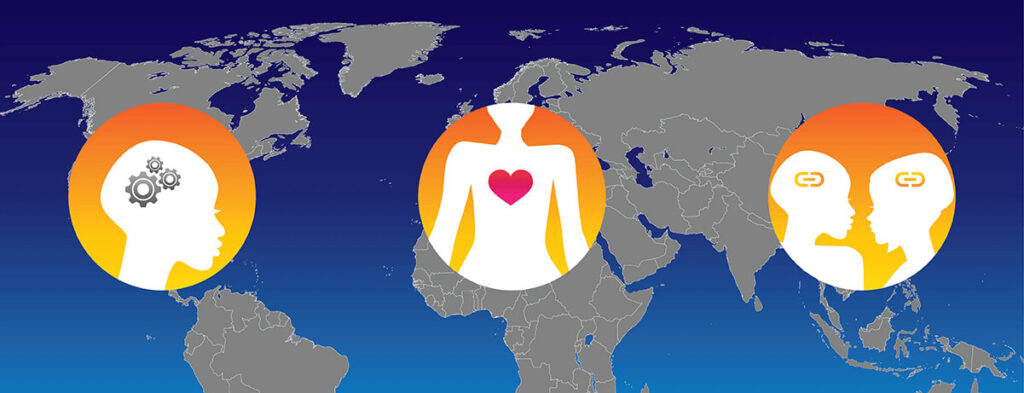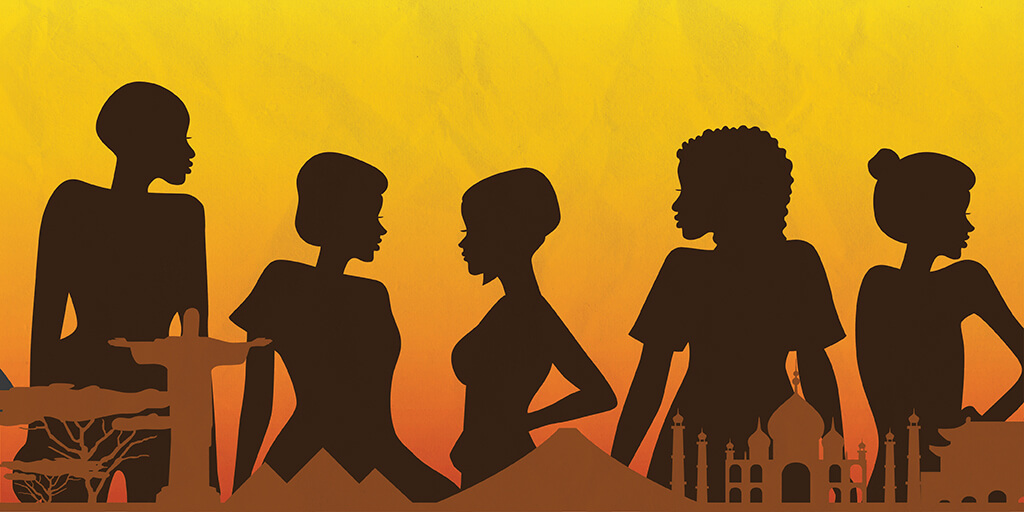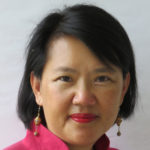Inspired by Margot Lee Shetterly’s famous book and subsequent blockbuster, Hidden Figures, on NASA women of color, Nijay Gupta at the University of Durham began to unearth the stories of ancient women who may have been ‘lost to history.’[1] He attempted to investigate ‘comprehensively’ the biblical times and culture, concluding, ‘I began to see the women that were there all along (just like the women of NASA in the twentieth century). . . . They are often key characters.’[2]
Women have always been grassroots leaders. But in the 21st century, women are transitioning from being grassroot leaders in the local Christian context to global leaders in the global Christian context. World Christianity today is already considered a women’s movement, as we witness the dramatic shift in global Christianity towards the Global South, with over 65 percent of all Christians living in Asia, Africa, Latin America, and Oceania in 2020.[3] Historian Dana Robert proposes that this global demographic shift can be considered a women’s movement because women are the major participants in the daily life of Christian activities.[4] Furthermore, a key finding from Women in World Christianity based on data from national censuses and Christian denominations, is that women now comprise the majority of churches worldwide.[5]

An African Woman is the Face of Christianity
Christianity is currently growing the fastest in Africa, Latin America, and Asia,[6] largely due to the significant growth paved by women for the past 200 years. Many nameless local ‘Bible women’ have spread Christianity throughout Asia and Africa in the 19th and 20th century. Similarly, women revivalists swept the gospel throughout the Azusa Street Revival in the United States (1906) and the Chilean Revival (1909). The ‘Balokole’ women or ‘saved ones’ ignited the East Africa Revival (1930s-50s).[7] Studies have indicated that two-thirds of Pentecostals in Central America were women.[8] Robert predicts that the ‘typical’ Christian in 2025 is likely to be an African or Latin American women.[9] Global researcher Gina Zurlo confirms that an African woman is the face of Christianity in the 21st century.[10] We are living in a time where non-Western women are the face of Christianity. While Western and non-Western women have always been grassroots leaders in the local context, they are now taking their place as global leaders who can mobilize diverse followers to accomplish a global vision.
The Breakthrough Century
The 21st century is pivotal for women as global leaders. According to Nancy Adler’s seminal research, 126 women served as prime ministers and presidents between 1950 and 2014, of whom 79 were the first women to lead their countries.[11] Women leaders—secular or religious, Western or non-Western— tend to model a leadership style ideal for this century because it is inclusive, participative, empathetic, trustworthy, and relational.[12] Adler observes about women global leaders, that they come from ‘the world’s most socially and economically advantaged and disadvantaged countries . . . from every geographical region, represent all six of the world’s major religions.’[13] This worldwide phenomenon now includes Christian women from every part of the world.
Cross-cultural Leadership: Multi-faceted Boundary Spanners
Women are predisposed to being cross-cultural leaders. A key finding from Women in World Christianity is that women tend to be boundary spanners who transcend the barriers of religion, age, class, and ethnicity in mission, social service, outreach, activism, and other areas. Women gravitate towards cross-cultural work and generally appear to be more comfortable in multicultural settings.
Women are also multi-faceted leaders who have always engaged in holistic missions—merging gospel proclamation with kingdom transformation, weaving mundane tasks with the hospitality of the saints, and teaching the Scriptures while binding up wounds.[14] Under the harshest circumstances, they display an unyielding strength to transform communities, be it rescuing people from trafficking, defending the voiceless, protecting the orphans, delivering victims from injustice, or pioneering literacy and medical care. Mary Lederleitner’s survey of 95 women mission leaders from 31 countries reveals that the key descriptor of these women leaders is that they are ‘faithful’ and ‘connected’ influencers.[15] It is vital that women lead authentically how women lead best, by fostering the intrinsic strengths of women in leadership.
Global Leadership is Extreme Leadership
While many women leaders have excelled as cross-cultural leaders, being global leaders requires the ‘extreme leadership’ to confront the ‘extreme complexity’ of the 21st century in four aspects:[16]
- Multiplicity—the increased number and range of issues.
- Interdependence—the complex knot of stakeholders, sociocultural, political, economic, technological, and environmental systems.
- Ambiguity—the lack of clarity caused by multiple interpretations about information, cues, relationships, and goals.
- Flux—the rapid rate of change, transitioning systems, shifting values, and differing emergent structures.
Proven cross-cultural leadership can be a springboard to global leadership with its added complexity and challenges. Women with bicultural and multicultural experience who identify with more than one culture and who overcome the high-contact challenges of going cross-culturally tend to be great potential global leaders.[17] Therefore, the first step for women to become global leaders is to gain meaningful bicultural or multicultural experience.

The Crucible of Becoming a Global Leader[18]
Many have called global leadership a crucible for handling extreme complexity in this 21st century. The key characteristic that distinguishes global leaders from cross-cultural leaders is that global leaders must acquire a ‘global mindset.’[19] While several models of global leadership have been developed, Mansour Javidan and Jennie Walker’s Global Mindset model is practical and applicable for women because it is based on diverse case studies by both men and women from Western and non-Western countries and on the research of 287 global executives, experts, and scholars worldwide.[20]
Global mindset comprises three large capitals of knowledge, behaviors, and attributes,[21] which simply put, represents the mind, heart, and social relationship of global leaders. For women in any part of the world to grow as global leaders, it is essential to proactively cultivate these three capitals:
Global intellectual capital (mind)[22]—the cognitive ability with three competencies:
- Acquiring knowledge of and transacting in your particular global industry.
- Gaining knowledge of the world, including cultures, geography, history, events, important persons, economy, and politics.
- Developing the ability to analyze, solve, and explain complex issues.
Global psychological capital (heart)[23]—the affective ability with three competencies:
- Stimulating passion for diversity, including the enjoyment of exploring, traveling, living, and knowing people in other parts of the world.
- Developing a quest for adventure to take risk and stretch one’s ability to face unpredictable challenges.
- Fostering the self-assurance to be enthusiastic, confident, comfortable, and witty in hard unfamiliar situations.
Global social capital (relationship)[24]—the social ability with three competencies:
- Nurturing the intercultural empathy to understand, connect, and work well with people from other cultures.
- Activating interpersonal impact by leading, negotiating, and leveraging key networks and people from other cultures.
- Developing the diplomacy to integrate multiple views, and to converse, listen, and collaborate with others.[25]
Multi-intelligent Authentic Leaders
To lead in a complex world, women need to be multi-intelligent global leaders: emotionally intelligent (EQ), socially intelligent (SQ), and culturally intelligent (CQ).[26] The good news is that women tend to score higher on EQ,[27] which includes self-awareness, emotional control, and empathy. Women also score higher on SQ,[28] as women tend to emphasize relationship, be socially aware, tap into relational networks, and use their interpersonal relational skills to lead.[29] Also, women are natural boundary spanners, which could predispose women to high CQ which is ‘to function and manage effectively in a culturally diverse setting.’[30] Additionally, several studies highlight that authentic leadership is the key to effective global leadership.[31] Women naturally cultivate an authentic leadership style that is positive, transparent, principled, and honest.[32] They lead out of their sense of self, with moral courage. They communicate vision and goals genuinely from the heart with fervor, balance, and warmth.[33] When women around the world have stepped forth as global leaders, they consistently bring hope, change, and unity.[34] The women global leader of the 21st century are multi-intelligent authentic world-changers.
But What About the Hindrances?
While hindrances for women in local and global leadership are well documented, I would like to highlight three of them and the proactive steps needed to overcome them:
First, we need to initiate systemic and structural improvements in many ministries to empower women to lead effectively. Many women have experienced disparities in renumeration, opportunities to leadership roles, and promotions.[35] Others have had to ‘work more for less pay,’ or treated as ‘maids’ expected to do the cooking for ministries.[36] Often, they feel like leaders ‘without a face’[37] or ‘invisible’ in meetings, being intentionally ignored, or excluded in communications.[38] Women have also been excluded from opportunities to speak at conferences, preach, teach, and in ordination.[39] These issues need to be addressed and rectified.
Men advocating and opening the doors is one of the most effective ways to create opportunities for women to lead.[40] Just this week, I was with a well-known ministry leader planning a possible joint book project on leadership which would include key global voices. He said to me, ‘Mary, let’s aim to have half of the contributors be women authors who are proven subject experts. It won’t be easy to achieve but let’s aim for that.’ We need more men like this who would advocate for the next generation of women leaders.
Second, we need to intentionally hold women’s places in leadership alongside their male counterparts. Historically, once many of the grassroots movements initiated by women become formalized—including movements led by Bible women, the Balokole women of East Africa, and the women revivalists in the US and China—they give way to men in official leadership with an inversely diminished role for women.[41] As grassroots organizations mature, we need to intentionally ensure women’s places of leadership.
Third, women need to speak up on behalf of women’s basic human right to lead. Perhaps one of the most painful factors is that often the obstacles to leadership come from other women. Research shows that ‘other women posed some of the greatest obstacles they faced in ministry,’ including harsh judgmental attitudes or silence. [42]
Personal reflection
I was blessed to have a father in governmental leadership who raised me up to be and do anything I dreamed of; a husband who urged me to pursue a doctorate in leadership; and Floyd McClung, the founder of our organization, All Nations, who challenged me to assume the top leadership role. While doors have opened up for me to lead and to speak at conferences, I mainly encouraged women leaders privately. However, three years ago. I was sitting in a roomful of mission leaders, when the leader of a significant global ministry mentioned that they have no women in their leadership team. I wanted to keep quiet. But the Lord nudged me, ‘If I have given you any influence or platform, you need to pave the way for the others, and not keep it for yourself.’ I raised my hand and spoke up graciously. Several men and women came up afterwards to thank me for giving voice to women in leadership. We need knowledgeable articulate voices about women in leadership, such as Nijay Gupta’s well-documented book, Tell Her Story. Let us give every woman the chance to define and tell her story.
Endnotes
- Nijay Gupta, Tell Her Story: How Women Led, Taught, and Ministered in the Early Church (Downers Grove: InterVarsity Press, 2023), 1.
- Gupta, Tell Her Story, 3.
- Todd Johnson and Gina Zurlo, eds., World Christian Encyclopedia, 3rd ed. (Edinburgh: Edinburgh University Press, 2020), 3-4.
- Dana Robert, ‘World Christianity as a Women’s Movement’, International Bulletin of Missionary Research, 30 (4) 30, no. 4 (2006), 180.
- Gina Zurlo, Women in World Christianity: Building and Sustaining a Global Movement (Hoboken: Wiley-Blackwell, 2023)
- Johnson and Zurlo, World Christian Encyclopedia, 3-4.
- Johnson and Zurlo, World Christian Encyclopedia, 27.
- Robert, ‘World Christianity,’ 180.
- Dana Robert, Christian Mission: How Christianity Became a World Religion (Hoboken: Wiley-Blackwell, 2009), 73-74.
- Gina Zurlo, Co-Director of Center for the Study of Global Christianity. Interview by Marry Ho, 16 May 2023, Zoom.
- Nancy J. Adler, ‘Shaping History in the 21st Century’, in Women as Global Leaders, ed. Faith Wambura Ngunjiri and Susan R. Madsen (Charlotte: Information Age Publishing, 2015), 25-31.
- Adler, ‘Shaping History’, 39.
- Adler, ‘Shaping History’, 39.
- Mary Lederleitner, Women in God’s Mission: Accepting the Invitation to Serve and Lead (Downers Gove: Intervarsity, 2018), 53.
- See the seven distinctives displayed by these faithful connected women leaders in Lederleitner, Women in God’s Mission, 52, 53, 211.
- Joyce S. Osland, ‘Introducing Global Leadership: Laying the Groundwork for Women as Global Leaders’, in Women as Global Leaders, ed. Faith Wambura Ngunjiri and Susan R. Madsen (Charlotte: Information Age Publishing, 2015), 5.
- Osland, ‘Introducing Global Leadership’, 12.
- Editor’s Note: See article entitled ‘Global Leadership for Global Mission’ by Mary Ho in the November 2016 issue of Lausanne Global Analysis, https://lausanne.org/content/lga/2016-11/global-leadership-for-global-mission.
- Roya Ayman and Karen Korabik, ‘Women and Global Leadership’, in Women as Global Leaders, ed. Faith Wambura Ngunjiri and Susan R. Madsen (Charlotte: Information Age Publishing, 2015), 57.
- Javidan and Walker, Developing Your Global Mindset, 16.
- Javidan and Walker, Developing Your Global Mindset, 16.
- Javidan and Walker, Developing Your Global Mindset, 17-18.
- Javidan and Walker, Developing Your Global Mindset, 18-91.
- Javidan and Walker, Developing Your Global Mindset, 19-20.
- See ways to develop global leadership competencies in Osland, ‘Introducing Global Leadership’, 11.
- Julie R. Breithaupt, ‘Multiple Intelligences of Effective Women Global Leaders: Emotional, Social, and Cultural Competencies’, in Women as Global Leaders, ed. Faith Wambura Ngunjiri and Susan R. Madsen (Charlotte: Information Age Publishing, 2015), 74.
- Breithaupt, ‘Multiple Intelligences’, 75.
- Breithaupt, ‘Multiple Intelligences’, 82.
- Breithaupt, ‘Multiple Intelligences’, 82.
- Breithaupt, ‘Multiple Intelligences’, 76.
- Sarah E. Saint-Michel and Valerie Claire Petit, ‘Becoming More Themselves: How Can Global Organizations Promote Women’s Authentic Leadership?’ in Women as Global Leaders, ed. Faith Wambura Ngunjiri and Susan R. Madsen (Charlotte: Information Age Publishing, 2015), 120.
- Ayman and Korabik, ‘Women and Global Leadership’, 58.
- Breithaupt, ‘Multiple Intelligences,’ 84.
- Adler, ‘Shaping History’, 42-45.
- Lederleitner, Women in God’s Mission, 115-116.
- Young Lee Hertig, ‘Without a Face: The Nineteenth-Century Bible Woman and Twentieth-Century Female Jeondosa’ in Women as Global Leaders, ed. Faith Wambura Ngunjiri and Susan R. Madsen (Charlotte: Information Age Publishing, 2015), 191-192, 195-196.
- Hertig, ‘Without a Face’, 186, 195.
- Lederleitner, Women in God’s Mission, 115-116.
- Hertig, ‘Without a Face’, 191-195.
- Lederleitner, Women in God’s Mission, 169-170.
- Hertig, ‘Without a Face’, 196.
- Lederleitner, Women in God’s Mission, 175-176.

